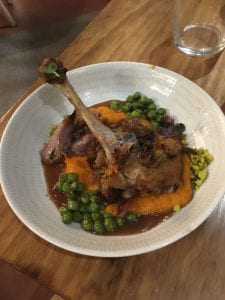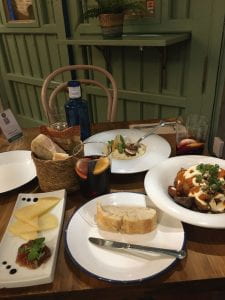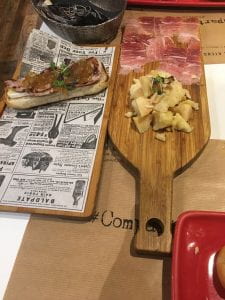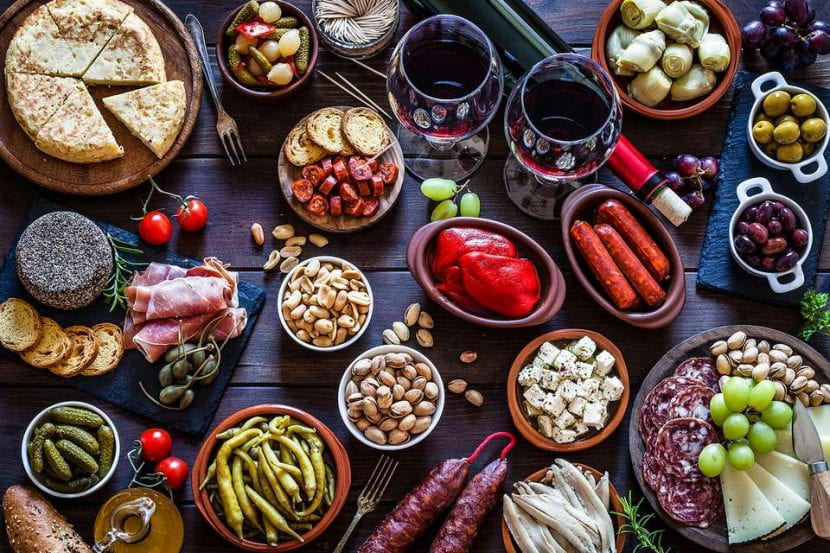As my last two blogs have detailed, the architecture of Spain is a very important part of its culture and flavor. The mix of Roman and Moorish influences create buildings that are uniquely built and uniquely beautiful. But, there were more important “flavors” to notice in Spain. The food, obviously (yeah, no buildup, I’m not in the mood). Specifically, the tapas. On the Iberian Peninsula, lunch is usually served between 1 and 3, while dinner is enjoyed at the later hour of 9. So, tapas are the sort of appetizers of Spanish gastronomy, served between lunch and dinner. It is has become a tradition that has transcended cultures: due to Spain’s influence on other countries due to its colonial power, many countries around the world have adopted Spain’s tapas culture. But, was the cuisine any good? If the tapas I ate were representative of what generally is served for tapas, than it was absolutely superb!
Tapas With Everything!

Tapas culture has endured in Spain for centuries, utilizing the staples brought in by the Romans and the Moors. Common dishes are tostas, which are open-faced sandwiches with various Iberian meats and cheeses layered on top. Also common are aceitunas (olives), bacalao (the never-dying salted cod), and paella (a rice dish commonly served with seafood). Of course, as is traditional in Andalusia, if you buy tapas, you are given a drink to accompany it, usually a beer or glass of wine. The same goes if you buy a cocktail; I was quite surprised to receive “complementary” tapas when I bought Sangria at a bar in Granada. The tapas I had were the perfect combination of filling and tasty, enough to do the job to bridge the gap between lunch and dinner without being bland. Some of the tapas I indulged in where downright delicious, including the best meal I have had so far on this trip. I will focus especially on that meal in the next section.
La Brunilda

While in Sevilla, Camille and I wanted to find a good tapas place to indulge ourselves in. As I looked on Google, a place nearby our hostel immediately popped up, before any other restaurant nearby (Google, you mind-reader…). I gave it a closer look, because it was also in my trusty student budget guide book I’ve been using throughout my time in Europe. I decided it looked appealing, and Camille was game for an adventure. And it was an adventure! The name of the place: La Brunilda. The location: a 10 minute walk away. We aimed to get there 30 minutes early. Yes, 30 minutes early. This was due to this place being insanely popular. We were 20th in line as we arrived at 8:05, 25 minutes before La Brunilda opened at 8:30. The restaurant was in a ill-used back alley, and only seated about 35, including bar seating. But, we got a table, and avoided the infamous waiting list, one that never is empty after this cozy little tapas bar opens. Menus are presented, and inside their pages awaits a smorgasbord of cheap options to choose from. That is the big draw of this place: the price range. Individual-sized tapas run from 4 to 6 euros, and share-sized tapas run from 8 to 12 euros. Drinks are cheap (1-3 euros). Everything’s cheap. But what we had to “sacrifice” in price, we did not have to sacrifice in quality. The food we indulged in was absolutely delicious. Camille and I each got 2 individual-sized tapas and a shared-sized one to split. I got a cheese plate (idiazabal cheese, a cheese both buttery and smoky) served with a fruit jam that was hard to identify, but paired perfectly with the textures and flavors of the cheese. Coming with the cheese plate was our shared dish, papas bravas. These are potatoes served with a slightly spicy sauce, as well as a yogurt sauce. The mixing of the two sauces, as well as the spices added on the potatoes made for an explosion of flavors when savoring a bite of the potatoes. It is one of the most popular tapas in Spain. My final tapa of the day was a meat dish, a duck leg served in carrot puree and with other vegetables. The succulent meat was so tender that it feel right of the bone, and the carrot puree worked surprisingly well with the duck. Although I’m no food critic and struggle mighty to convey how these foods tasted, perhaps one simple word will suffice: Scrumptious.
A Quick Description of Other Tapas Eaten

I tried a decent amount of tapas on this trip. Here is a brief description of the other things I ate before my salutations.
Seafood Paella: A classic in Spain. Cooked rice served with various types of seafood and vegetables. Mine had squid rings, and a couple types of mollusks. I had this in Granada.
Tosta #1: This tosta was a quarter of a wheat baguette with Brie, sirloin, and caramelized onions. It was probably the best tapas I had other than what I ate at La Brunilda. I had this in Granada.
Meat and Cheese Plate: This was my first taste of Iberian ham, something that a person I met in my hostel described as tasting like a rather unsavory part of the body. I didn’t think so. It was adequately tasty; I enjoyed the cheese much better. I had this in Granada.
Empanadilla: Both the son and father of the empanadas we all know and love in the US. It is the inspiration for the American version, but is much smaller. Mine came with chicken and vegetables, and was a good snack-sized package of flavor. I had this in Sevilla.
Tosta #2: This one wasn’t anything special. The first tosta I had was much better. This one had Iberian ham, and nothing else. I just got it as a quick snack for on-the-go that was cheap. I had this in Sevilla.
Thanks yet again for reading. I can’t believe this is the 20th blog post I have managed to write since I started! I have done much better than my original goal of an average of one per week. I have managed to find the time and effort to average exactly 2 per week! Sorry for all the self back-patting. I need it right now. I will go on a brief hiatus for the next 10 days, in which my midterms will be done. Expect a blog detailing my study experiences in Lisbon over this period. Afterwards? A whole lot of adventures coming your way. Just today I booked a trip with the Erasmus Life organization to “Serra da Estrela” the highest mountain range in continental Portugal. The following weekend is Amsterdam. After that, I very well may be journeying to Coimbra, home to a university founded in the 13th century! The following week, I wrap up classes, and then go to Budapest, followed by France, and then return home. Expect blogs on all of those travels to be detailed, as well as some reflections as I finish up. That probably means I have 10-12 posts left in me before this all over. Stay with me to hear about all of the above! I hope you continue to enjoy my writings. Until next time,
Jeremy Caldeira


Great food descriptions!
YUM, YUM! Everything sounded so good. Glad you are enjoying every aspect of your journey…A. Janet
Tapa is a type of food made from the meat of cows, pigs, or chickens. It is a dish served as a side dish or as an appetizer. It is commonly eaten in the Philippines and in other countries in the Pacific Rim. I will visit reliable website now. This dish is served in different ways, such as with garlic and vinegar, soy sauce and salt, or vinegar and sugar. It can be eaten with white rice or with a salad.
Tapas are the sort of appetizers of Spanish gastronomy, served between lunch and dinner. The type of tapas that is served in a tapas bar differs from the type of tapas that is served in a restaurant and from the type of tapas you can get in a supermarket.In general, the concept of serving small portions at high prices has been around for centuries in Spain. However, there are some differences between the traditional version and its modern counterpart. I would like to get want to pay for a paper now. For example, there are no printed menus in most bars or restaurants in Spain; instead, they have chalkboards on which you can write down what you want to eat or drink.
Thanks for the information, everything is written in such detail.
Check my website https://paperwritingwebsites.blogspot.com/2023/06/best-research-paper-writing-services.html
Can you explain the concept of “tapas” in Spanish cuisine and its cultural significance? How does it contribute to the overall dining experience in Spain?
telkom University
Love this article. WLK Classic Gold can be used to purchase a variety of items in WLK. You can get Cheap & Safe & Fast WotLK Classic products at https://www.ssegold.com
ALEXISTOGEL merupakan link rekomendasi bandar togel hongkong terbaik dan terpercaya yang memiliki minimal pemasangan hanya 100 perak dengan hadiah 4d terbesar.ALEXISTOGEL
ALEXISTOGEL adalah situs slo*t online terbaik dengan permainan s*lot gacor resmi winrate tertinggi setiap hari untuk Anda. Daftar dan Claim Bonus Member Baru 50%, Raih keuntungan sebanyak-banyaknya!ALEXISTOGEL
TESLATOTO merupakan agen sl*ot yang mudah menang di lengkapi dengan persentase kemenangang yang tinggi dan pastinya terpercaya.TESLATOTO
Kobamtoto merupakan salah satu situs resmi dan juga terpercaya di Indonesia dengan adanya situs slot gacor hari ini terbaru sangat memungkinkan para pemain dalam mendapatkan keuntungan yang banyak.
JNETOTO adalah salah satu situs bandar togel online hongkong tepercaya yang memberikan data keluaran hongkong dan pasaran togel lainnya secara resmi dan lengkap hingga menyediakan prediksi angka terakurat.JNETOTO
Your latest blog post continues to captivate readers with your experiences in Spain. Your detailed descriptions of the tapas culture and the specific dishes you tried make us feel as if we are part of your culinary journey. The excitement and enthusiasm in your writing are infectious, and we appreciate your effort to share your experiences with us.
Your focus on La Brunilda, a popular tapas bar in Seville, is well-appreciated. Your account of the place, its ambiance, and the variety of dishes you tried is engaging, making us crave the flavors you described. Your use of words like “scrumptious” and “explosion of flavors” paints a vivid picture for the readers, making them want to visit the place themselves.
The brief descriptions of other tapas you tried add variety to your narrative and give readers a glimpse of the diverse food culture in Spain. Your honest opinions about each dish make the content relatable and help readers understand your preferences.
Your commitment to writing a blog post every week is commendable, and your readers appreciate the consistency. The upcoming adventures you have planned, along with your reflections on your journey, are something we are looking forward to reading.
Continue to share your experiences and insights with your audience, and keep them engaged with your journey through Europe. Your passion for exploring new cultures and learning is truly inspiring.
Best regards,
khalidelarbi——————business for sale
ALEXISTOGEL adalah situs bandar togel dan slo*t gacor terpercaya yang menyediakan permainan terlengkap dengan minimal deposit hanya 5 ribu.
ALEXISTOGEL
Tangkasjitu merupakan situs bola terbaik dengan adanya banyak sekali keuntungan untuk para pemain, dengan memberikan banyak sekali bonus serta promosi untuk para pemain juga.
It’s very good because it has online lottery games with the biggest prizes and very attractive bonuses. therefore I really like it. for further information please visit https://jari4dslotgacor.com/
Very helpful article, please check out our site.
Togel118 Trusted gacor slot site that collaborates with Mainpetir.com as the best ambassador.
Teslatoto merupakan situs bandar slot gacor terlengkap yang menyediakan RTP semua game slot yang ada di indonesia. Dengan adanya fitur RTP teslatoto para pemain slot tidak perlu lagi sibuk mencari rekomendasi slot gacor hari ini karena semua sudah ada dan tersedia secara up to date dan real time sehingga pemain dapat menang besar pada saat itu juga. segera bergabung dan login teslatoto untuk mendapat kemenangan terbesar anda sekarang juga.Teslatoto
Berkumpul bersama di Paris88, di mana keseruan tak terbatas! Siapkan diri Anda untuk mengalami petualangan luar biasa dengan ribuan slot menarik yang siap mengantar Anda pada kemenangan besar. Daftarlah hari ini dan raih peluang emas ini untuk meraih keberuntungan sejati!
Link Daftar : https://heylink.me/paris88.com
If you want to know about a very interesting site guaranteed by Maxwin, please just visit our website
https://wisdomtoto.xyz/
This game can generate profits, with very little capital you can reap big wins, don’t believe it, prove it yourself, this site is the best online lottery site that provides benefits from playing online games, for further information please visit this website
https://wisdomtoto.io/
asiabet62 merupakan situs slot gacor online terpopular se Asia yang menyediakan banyak sekali keuntungan besar besaran untuk para pemain, mainkan sekarang juga situs slot gacor asiabet62 dan dapatkan keuntungan yang banyak
INDOBET62 situs dimana sangat ramai dimainkan sudah menjadi kepercayaan seluruh Indonesia memberikan banyak sekali keuntungan untuk para pemain
This information has me giddy! The author has clearly taken considerable care to deliver insightful and helpful information. I couldn’t resist booking a session as a kind gift for a friend after learning about SEV Laser. The encounter filled them with immense joy! After reading so many positive reviews and seeing how much fun people had with their sessions, I felt compelled to express my enthusiasm. Anyone considering Laser Hair Removal in Austin should definitely check out SEV Laser. Thank you for sharing your excellent content.
Paris88 – Situs Game Judi Resmi Slot Online Gacor Hari Ini Hadiah Terbesar di Indonesia Partner Slot88
“Maximize your football betting wins! Discover expert tips and strategies to pick the best odds and boost your earnings.
Read now!
Score Big with Premier League Betting at JBO Thailand! Bet on your favorite teams and enjoy exclusive bonuses. Join now and experience the thrill!
Premier League Betting
Score Big with Premier League Betting at Fun88 Thailand! Bet on your favorite teams and enjoy exclusive bonuses. Join now and experience the thrill!
Premier League Betting
Score Big with Premier League Betting at Fun88 Thailand! Bet on your favorite teams and enjoy exclusive bonuses. Join now and experience the thrill!
Dun88 Thailand
Great article. Will give it a read once more.
You write well I really like what you write. spade gaming ทางเข้า
Great website you have here. You have such a beautiful way of writing. Thank you for sharing this, it’s very helpful for some people like me.
Karya Bintang Abadi